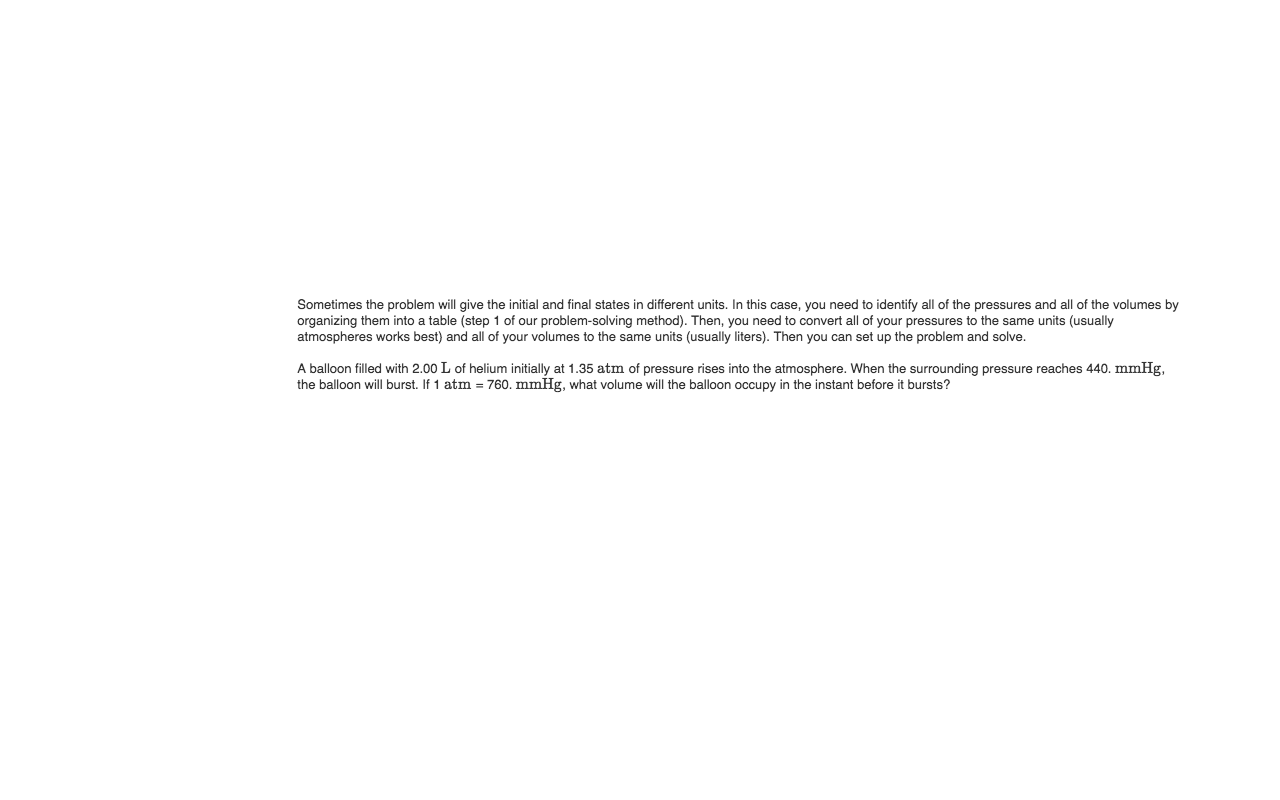Sometimes the problem will give the initial and final states in different units. In this case, you need to identify all of the pressures and all of the volumes by organizing them into a table (step 1 of our problem-solving method). Then, you need to convert all of your pressures to the same units (usually atmospheres works best) and all of your volumes to the same units (usually liters). Then you can set up the problem and solve. A balloon filled with 2.00 L of helium initially at 1.35 atm of pressure rises into the atmosphere. When the surrounding pressure reaches 440. mmHg, the balloon will burst. If 1 atm = 760. mmHg, what volume will the balloon occupy in the instant before it bursts?
Sometimes the problem will give the initial and final states in different units. In this case, you need to identify all of the pressures and all of the volumes by organizing them into a table (step 1 of our problem-solving method). Then, you need to convert all of your pressures to the same units (usually atmospheres works best) and all of your volumes to the same units (usually liters). Then you can set up the problem and solve. A balloon filled with 2.00 L of helium initially at 1.35 atm of pressure rises into the atmosphere. When the surrounding pressure reaches 440. mmHg, the balloon will burst. If 1 atm = 760. mmHg, what volume will the balloon occupy in the instant before it bursts?
Chemistry for Engineering Students
3rd Edition
ISBN:9781285199023
Author:Lawrence S. Brown, Tom Holme
Publisher:Lawrence S. Brown, Tom Holme
Chapter10: Entropy And The Second Law Of Thermodynamics
Section: Chapter Questions
Problem 10.18PAE
Related questions
Question

Transcribed Image Text:Sometimes the problem will give the initial and final states in different units. In this case, you need to identify all of the pressures and all of the volumes by
organizing them into a table (step 1 of our problem-solving method). Then, you need to convert all of your pressures to the same units (usually
atmospheres works best) and all of your volumes to the same units (usually liters). Then you can set up the problem and solve.
A balloon filled with 2.00 L of helium initially at 1.35 atm of pressure rises into the atmosphere. When the surrounding pressure reaches 440. mmHg,
the balloon will burst. If 1 atm = 760. mmHg, what volume will the balloon occupy in the instant before it bursts?
Expert Solution
This question has been solved!
Explore an expertly crafted, step-by-step solution for a thorough understanding of key concepts.
This is a popular solution!
Trending now
This is a popular solution!
Step by step
Solved in 2 steps with 2 images

Knowledge Booster
Learn more about
Need a deep-dive on the concept behind this application? Look no further. Learn more about this topic, chemistry and related others by exploring similar questions and additional content below.Similar questions
Recommended textbooks for you

Chemistry for Engineering Students
Chemistry
ISBN:
9781285199023
Author:
Lawrence S. Brown, Tom Holme
Publisher:
Cengage Learning

Chemistry: An Atoms First Approach
Chemistry
ISBN:
9781305079243
Author:
Steven S. Zumdahl, Susan A. Zumdahl
Publisher:
Cengage Learning

Chemistry: Principles and Reactions
Chemistry
ISBN:
9781305079373
Author:
William L. Masterton, Cecile N. Hurley
Publisher:
Cengage Learning

Chemistry for Engineering Students
Chemistry
ISBN:
9781285199023
Author:
Lawrence S. Brown, Tom Holme
Publisher:
Cengage Learning

Chemistry: An Atoms First Approach
Chemistry
ISBN:
9781305079243
Author:
Steven S. Zumdahl, Susan A. Zumdahl
Publisher:
Cengage Learning

Chemistry: Principles and Reactions
Chemistry
ISBN:
9781305079373
Author:
William L. Masterton, Cecile N. Hurley
Publisher:
Cengage Learning

Physical Chemistry
Chemistry
ISBN:
9781133958437
Author:
Ball, David W. (david Warren), BAER, Tomas
Publisher:
Wadsworth Cengage Learning,

Chemistry: The Molecular Science
Chemistry
ISBN:
9781285199047
Author:
John W. Moore, Conrad L. Stanitski
Publisher:
Cengage Learning

Chemistry: Principles and Practice
Chemistry
ISBN:
9780534420123
Author:
Daniel L. Reger, Scott R. Goode, David W. Ball, Edward Mercer
Publisher:
Cengage Learning